Physical Address
304 North Cardinal St.
Dorchester Center, MA 02124
Physical Address
304 North Cardinal St.
Dorchester Center, MA 02124

What shoes do babies wear at 6 months? At 6 months old, your baby is a whirlwind of development! They’re rolling over, reaching for objects, and maybe even babbling up a storm. You might wonder if it’s time for their first pair of shoes. The American Academy of Pediatrics (AAP) recommends waiting until your baby starts walking before introducing shoes. In the meantime, socks are the best way to keep your little one’s feet warm and protected.
This article explores why shoes aren’t necessary for 6-month-olds and the importance of barefoot time for healthy foot development. We’ll also discuss socks as a great alternative and offer tips for choosing socks that fit your baby well.
Letting your baby explore barefoot is actually the best footwear choice for their early development. Here’s why:
Bare feet allow babies to feel different textures and sensations. This sensory input helps their brains develop and learn about their environment.
When barefoot, babies can grip the floor with their toes, which helps strengthen the muscles in their feet and ankles. This lays the foundation for good balance and coordination later on.
Shoes can sometimes restrict the growth of a baby’s foot. Going barefoot allows their feet to develop naturally, with plenty of space for the toes to wiggle and spread.
So, the next time your little one is crawling around the house, let those toes be free!
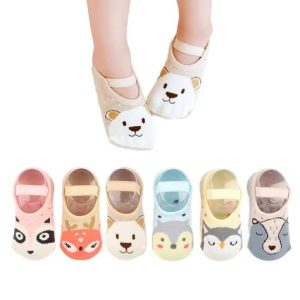
Once your baby starts walking, shoes can help protect their feet from injuries and the elements. However, it’s important to choose shoes that are designed for new walkers. Here are some key features to look for:
Soft and Flexible Soles: Stiff soles can hinder natural foot development. Look for shoes that bend easily at the toes.
Supportive but Not Restrictive: The shoes should provide some support for the ankle, but not be so tight that they restrict movement.
Good Fit: Shoes that are too big or too small can cause blisters and discomfort. Make sure there’s a little bit of wiggle room for your baby’s toes.
Talk to your pediatrician for guidance on choosing the right shoes for your baby when the time comes.
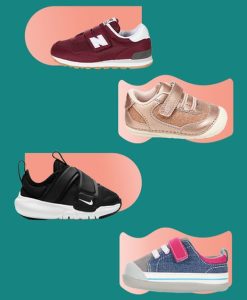
Socks are a great way to keep your baby’s feet warm and protected while they’re not walking. Here are some things to consider when choosing socks for your 6-month-old:
Material: Look for soft, breathable materials like cotton or bamboo. These will help keep your baby’s feet comfortable and prevent sweating.
Size: Socks that are too big can slip off easily, and socks that are too tight can restrict blood circulation. Choose socks that fit snugly but comfortably.
Grip: Socks with grips on the soles can help prevent your baby from slipping on smooth surfaces.
With a variety of cute and colorful options available, socks can be a fun way to add some personality to your baby’s outfit!
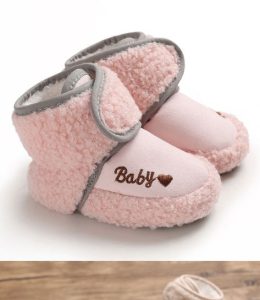
While it might be tempting to put tiny shoes on your adorable 6-month-old, letting them explore barefoot is actually the best thing for their growing feet. Barefoot time allows for important sensory development, strengthens muscles, and promotes natural foot growth. Socks are a great option to keep your baby’s feet warm and protected when they’re not walking.
So next time your little one is wiggling their toes, let them enjoy the freedom of being barefoot! There’s a whole world of exploration waiting for them, one tiny step at a time.
Before delving into specific types of shoes, it’s crucial to understand the development of baby feet. At six months, infants are typically mastering the art of sitting up and may even be attempting to crawl. Their feet are still soft and pliable, with bones that are not fully formed.
Experts generally agree that barefoot is best for babies learning to walk. When indoors, allowing your baby to explore barefoot aids in the development of balance and coordination. The sensation of different textures underfoot helps stimulate sensory development.
When venturing outdoors or in situations where protection is necessary, soft-sole shoes are ideal for babies at six months. These shoes provide a minimal barrier while still allowing the feet to flex and grip the ground. Look for shoes made from breathable materials to keep tiny feet comfortable.
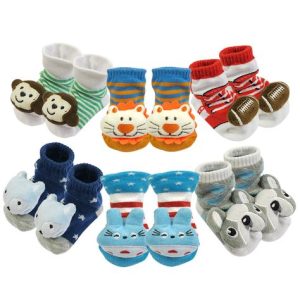
Crib shoes, also known as pre-walkers, are designed for infants who are not yet walking. These shoes feature soft, flexible soles and are primarily used for warmth and style rather than support. Crib shoes come in various adorable designs, making them a popular choice for baby fashion.
During colder months, booties and socks provide warmth and protection for baby feet. Opt for booties with soft, non-slip soles to prevent slipping on smooth surfaces. Ensure that socks are not too tight, allowing for proper circulation.
When selecting shoes for your six-month-old, prioritize proper fit over style. Baby feet grow rapidly, so it’s essential to regularly check for size changes. Look for shoes with room to wiggle toes and a secure closure to prevent slipping off.
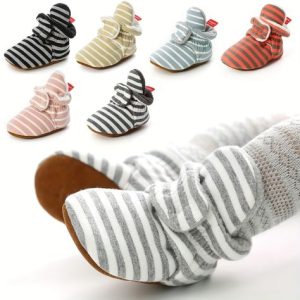
As your baby becomes more confident in standing and walking, typically around the age of one, you may consider transitioning to hard-soled shoes. However, continue to prioritize flexibility and comfort to support natural foot development.
While soft-sole shoes are ideal for everyday wear, certain occasions may call for different types of footwear. For formal events or outings, consider soft-soled dress shoes that complement your baby’s attire while providing comfort and style.
During outdoor activities such as hiking or strolling in the park, opt for shoes with sturdy soles and ankle support to protect against rough terrain. Look for features such as adjustable closures and moisture-wicking materials to keep your baby’s feet secure and dry.
In conclusion, babies at six months benefit most from barefoot exploration indoors and soft-sole shoes for outdoor adventures. Keep in mind the importance of proper fit, breathability, and flexibility when selecting footwear for your little one.